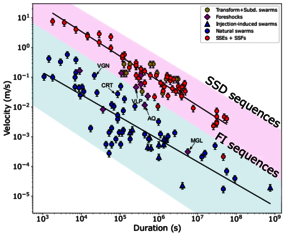Some interesting features of natural and injection-induced earthquake swarms
Earthquake swarms are a peculiar type of earthquake sequence : instead of exhibiting a clear mainshock and the expected seismicity decay after it, they rather consist in a continuous yet moderate seismicity episode. Their durations, tectonic contexts, moment released, etc. also vary : some swarms last for years while other are only a few days long for instance. Swarms have been observed both in natural tectonic context (rift zones, subduction zones, even intraplate areas) and in association with anthropogenic injections at depth (deep geothermal activities for instance). Despite this great diversity, they still show similar features : an overall seismicity migration, faster bursts within the swarm, a suspected (or established) fluid or aseismic slip presence, a weak moment compared to the active seismicity area, a seismicity backfront, etc.
In my work, I analyzed tenths of earthquake swarms,natural and injection-induced, to highlight their similarities or differences. Through migration analysis, a theoretical mechanical framework and scaling laws, it appears that most swarms are driven by a fluid-induced aseismic slip in a similar way. This leads to interesting perspectives regarding our understanding of seismicity triggering by fluid injections, or fluid dynamics during natural earthquake swarms, and paves the way to future work on refined seismicity catalogs to gain even more insight into these sequences.

